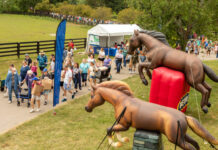1. Boarding Barns
Before you arrange to bring your new horse home, you must decide where he’s going to live. If you live on a farm with a barn and fields, problem solved! But if you don’t, you’re going to have to find a boarding barn. The best way to find out about barns is by word of mouth. Ask your friends who ride where they keep their horses. A good boarding barn will have large, clean stalls and safe turnout fields, paddocks and corrals. It should also have an arena where you can safely ride. If you want to trail ride, find a barn that is near trails. Look for a barn that has other riders your age. You don’t want to be the only kid at the barn. Start researching barns before you buy a horse. Why? If a barn is full, you may have to go on a waiting list and it could be a while before you can take your horse there.

If you live on a farm, you still have to have some basic facilities if you plan to bring a horse home. You should have grassy fields with safe fencing or corrals or paddocks for turnout time. The field should have natural windbreaks like hedges or trees to protect your horse from bad weather. Ideally your field will have a run-in shed in it. Even if you plan to keep your horse outside, your farm should have a barn with 12’ by 12’ stalls so you have somewhere to put your horse if the weather is really terrible or if he gets hurt and needs stall rest.
If you live in a hot climate and horses live in pipe corrals, your horse should have some sort of shade.
Your horse must have some sort of water source so he can drink whenever he likes. If your field doesn’t have an automatic waterer, you need to put a large trough in it and fill it with water every day.
3. Call the Vet
Establish a relationship with a local equine veterinarian. If you don’t know one, ask your horsey friends who they use. If you plan to board at a barn, the manager should be able to recommend a vet. Call the vet to see if he or she is accepting new clients before your new horse arrives.
4. Befriend a Farrier
Word of mouth is probably the best way to find a good farrier. Some boarding barns use farriers who come out on a regular basis, so try to meet one of them and let him know you’ll need his services in the near future. Find out how much your new farrier charges for trimming or shoeing, so you’re not surprised the first time he hands you a bill.
Remember to ask your new horse’s current owners if your horse has any special shoeing needs.
5. What’s For Dinner?
Figure out what your horse is going to eat when you bring him home. Ask his current owners what type of feed he eats. Does he munch on pellets or sweet feed? How much hay does he need to eat every day? What kind of hay does he eat?
If you plan to change his feed, do it gradually. Let him eat his old feed for about a week and then begin giving him half old feed half new feed for a few days. Gradually increase the new feed until he’s only eating new feed.
If you’re boarding your horse, it’s likely that the barn will provide hay. If you plan to keep your new horse at home, you’ll have to buy your own hay. It’s much cheaper to buy hay in bulk from a local farmer rather than one bale at a time from a feed store, so start searching for hay sources now. You don’t want to have a hay shortage in the middle of winter. Ask your friends how many bales their horses eat each year and buy a similar amount if you can. Some farmers deliver hay, but sometimes you have to collect it yourself in a truck.
6. Grooming Gear
You should have a fully-stocked grooming kit before your new horse arrives. This means a box of gear just for him, containing a metal curry comb, rubber curry comb, dandy brush, soft brush, mane and tail combs and brushes and a hoof pick. You’ll also need a bucket, sponges, shampoo and a few towels for bathing your new mount.
7. Time to Tack Up
It’s a good idea to sort out your horse’s tack before he arrives. Does your saddle fit him? If not, you may have to start a saddle search. You should be able to easily purchase a bridle, bit, saddle pad/blanket, and girth/cinch. Ask the horse’s current owner what sort of bit he uses and go buy one if it works. Do you plan to jump or gallop your new horse? If so, protective splint boots for his front and rear legs should be the next things on your list to buy.
8. Blanket Bonanza
If you live in a cold climate and your horse is going to be clipped, you need to buy him a blanket or two to keep him warm. Ask your pony pals what kind of waterproof blankets they use and what weight your horse will need. In most areas, a medium-weight blanket is a good choice. If it gets pretty buggy where you live in the summer, you might want to invest in a fly sheet for your new friend.
9. Be Prepared in an Emergency
If you take care of a horse, you should have a first aid kit kept in a handy place. Ask your vet what items it needs to contain. Most kits include stretchy bandages, absorbent padding, a thermometer, antibacterial cream, scissors, duct tape, fresh non-steroidal eye ointment and antiseptic scrub.
10. Trainer Talk
If you don’t have a trainer, it’s a really good idea to find one who can help you with your new horse. If you’re going to board at a barn, there may be an on-site trainer or a trainer who visits regularly. Ask the other boarders who you should try as a trainer. If your horse will be kept at home and you’ve got a trailer, you can travel to a trainer. If you don’t have transportation, you might find a trainer who will come to you if you have a flat, safe area where you can ride. If you’ve got the cash, try to have at least two lessons a month. Both you and your horse will benefit from regular lessons.





